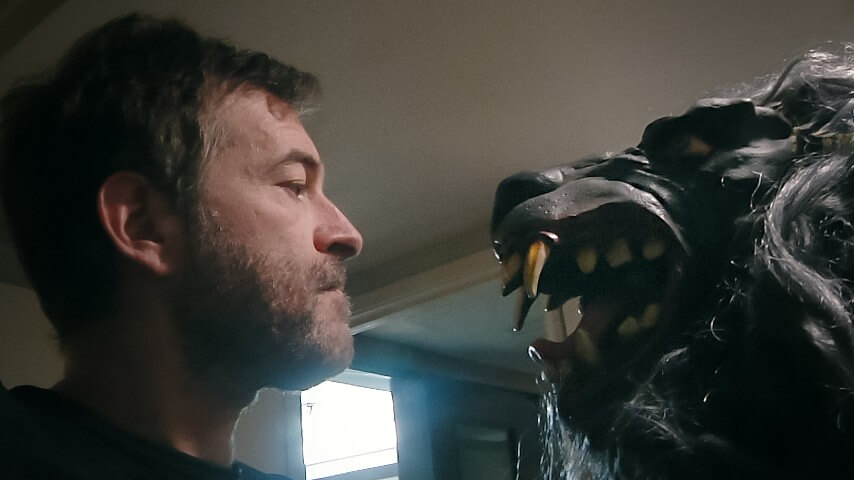The Creep Tapes is a killer expansion of a found-footage franchise
Mark Duplass’ gnarly murderer makes his way to the small screen.
Photo: Shudder
If Patrick Brice and Mark Duplass’ Creep must be a franchise, then The Creep Tapes is the optimum playground for it. Honestly, it feels like their found-footage horror series was preordained to be an anthology, given the finale of 2015’s Creep, where it was revealed that its serial killer lead, “Peachfuzz” (Duplass), was far more prolific than viewers may have initially grokked. His murder of Adam (Brice) was just the latest in an archive of video-recorded slaughter. Had Brice and Duplass attempted to wring a movie from each name in this death gallery (they originally planned a trilogy), they’d be making Creeps from here to doomsday.
Luckily, their horror-comedy concept (deployed with even more creative zeal in 2017’s Creep 2) is tailor-made for streaming. And should the viewing numbers justify more seasons of this particular brand of weird, The Creep Tapes could prove boundless as an anthology. What’s more, the cult following that has since assembled around Creep shows it has a built-in audience, and Brice and Duplass’ elegant premise can easily sustain multiple rounds of Peachfuzz’s mirth and mayhem.
This endorsement shouldn’t suggest that The Creep Tapes is entirely without flaws. Its fourth episode, “Jeremy,” stinks, which explains why it’s stashed in the middle of the other vastly superior installments in this darkly compelling, frequently hilarious season. But it’s easy to ignore. “Jeremy” is the extreme version of Creep that all other installments (films included) threaten to morph into, a broadly sketched goof-off session where Duplass goes full ham and the frightening aspects of his conceit (co-written with Brice) wilt into nothing. Creep needs to be funny (it would be far too bleak otherwise), but it also needs to be scary. When the balance tips too far in either direction, Creep becomes neither. “Jeremy,” a quickie concerning an online “gotcha” artist (Josh Fadem) who confronts a bawdy priest (Duplass in a cassock), proves this with grating clarity.
That episode notwithstanding, Brice and Duplass are showcasing their mastery of the anthologized format here. As a subgenre, found footage can be a tricky gimmick. The immersion required to be effective demands an attentive storyteller, deft camerawork, and committed performances. There’s also a fourth-wall-breaking element at play, as the viewer should feel they’re in on what’s happening onscreen. The Creep Tapes maintains the hand-held immediacy of the films—with those obnoxiously effective jump-scares, moments where Peachfuzz lets his mask slip (on or off) while his victim carries on unaware, and other subtle forecasts of doom—which makes it feel absorbing, even transgressive, as if one has clicked too deeply into the forbidding corners of the internet. At its best, The Creep Tapes transcends its content-mill trappings and becomes something approaching a work of art.
Creep has always been about performance, the push and pull between the actor and his rapt audience of one. Brice and Duplass toy with awkward (and, yes, lethal) social situations, having their players react in predictable or unpredictable ways depending on the scenarios they cook up. It’s a sturdy premise—generally, each episode features ‘Fuzz offering some poor dope $1,000 to film him until he decides to drop the axe—and Duplass is the draw. Sure, Desiree Akhavan was Duplass’ equal in Creep 2. But without her (and the fact that The Creep Tapes can’t dig as deeply into its hapless victims, with each episode running under 30 minutes), Duplass has to take command.
One quibble about this economy of story is that the inevitable has to be fast-tracked in lieu of an engrossing game of cat and mouse. Sometimes, the motivations of Peachfuzz’s victims are clear enough that the truncated nature of their demise doesn’t distract from one’s morbid enjoyment of it, as is the case of episode two, “Elliot,” in which a birdwatching enthusiast (David Nordstrom) stumbles across a stranger in the middle of nowhere. Peachfuzz’s introduction to Elliot’s story is so ridiculous that it beggars belief, but it’s effective—and just one example of how nimble Brice and Duplass can be in this stricter format.
Intriguingly, there are some attempts to deepen the lore of the killer. That gnarly wolf’s mask he’s prone to wearing (and which gives him his namesake) takes on a strange aspect in “Brandt,” where Duplass’ character attempts to disassociate from his persona. He denounces his co-dependency with it only to then engage in a warped conversation with the mask. “Brandt” is handily the most experimental episode of The Creep Tapes, a cracked, one-man version of Skinamarink, replete with a static soundtrack, disorienting compositions, and an exchange of bone-chilling whispers.
Another note on Duplass: At 47, the actor has become a grayer and somehow gentler fiend than his prior incarnations, and his huffy Peachfuzz urbanity now feels less like a hipster put-on than a sign of a man embracing earthier middle age. Duplass is also more playful than ever, as we see in episode one, “Mike,” where he monologues as a dollar-store vampire. There’s a liveliness to his performance that makes The Creep Tapes a worthy and unmissable expansion of the film series. And with new ticks for Peachfuzz (expect even more hips-gyrating skeeziness), the ick-factor of Creep is indeed higher than ever—yet tough to look away from. This guy gets up to so much heinous shit in this series, but it’s weirdly impossible not to be at least partially charmed and fascinated by him. Talk about creepy.
The Creep Tapes premieres November 15 on Shudder and AMC+